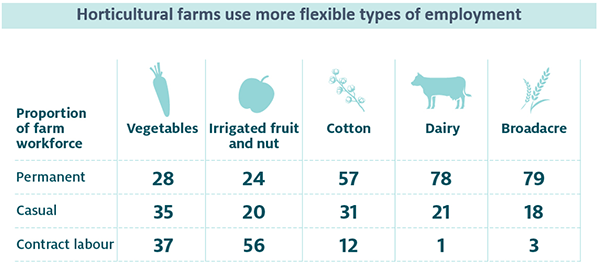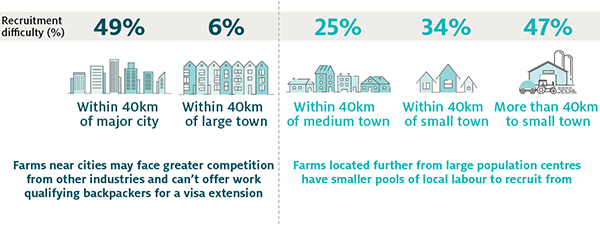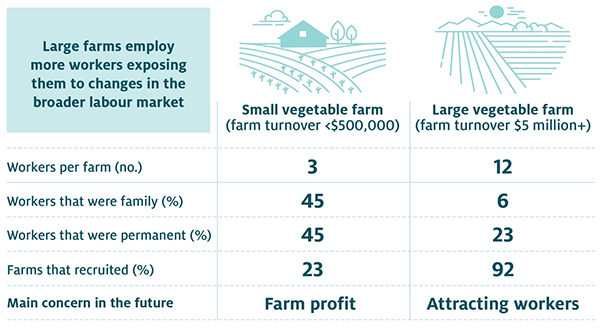Authors: Niki Dufty, Peter Martin and Shiji Zhao
ABARES 2018 surveys provide an-depth profile of labour demand, recruitment difficulties and future challenges farmers face.
The surveys covered broadacre, dairy and vegetable industries across all states, together with irrigated cotton and fruit and nut farms in the southern Murray Darling Basin. In aggregate these industries account for 74% of total Australian agriculture sector employment.

Key findings
Differences between agricultural industries, farm size and location shape the demand for labour, workforce make-up and recruitment experiences of farms.
Horticulture farms use large numbers of low-skilled workers from overseas

Family and other Australian workers make up the majority of the agricultural workforce. The dependence on workers living nearby highlights the importance of a pool of local workers to agricultural industries and may reflect limited mobility in the Australian agricultural workforce.
Horticultural farms reported the most use of workers on a visa to help meet seasonal needs. The dependence on overseas workers in these industries exposes farms to changes in visa arrangements.

The use of contract workers by horticultural farms is widespread. Around 10% of horticulture workers were contract labour with an unknown background. Although a minority of farmers we surveyed didn’t know the background of some of their workers, it is possible someone else in their farm business would have known. Not knowing the background of contract labour puts farmers at risk of using undocumented workers from unscrupulous labour hire companies.
Rates of recruitment were low and few horticulture farms had difficulty

Rates of recruitment were relatively low for agriculture compared to the rest of the economy. Low rates in part reflect the dominance of family labour reducing the need to recruit.
The survey found some farmers reporting recruitment difficulties in each industry. Few horticulture farms had difficulty recruiting, but a higher proportion of dairy and broadacre farms had difficulties. For horticulture farmers in particular, the low skilled nature of the work, the use of contract labour and access to backpackers appears to reduce recruitment difficulties faced.

Farms had more difficulty recruiting higher skilled positions. This issue is not unique to agriculture and highlights the importance of access to agricultural training and the need to offer competitive wages and conditions.

Farmers further from large population centres generally had more difficulty recruiting, except for vegetable farmers located near cities—where backpackers have less incentives to work and farms may face greater competition for workers from other industries. Any changes to the regional eligibility criteria for backpacker (working holiday maker) visas would likely change the areas backpackers seek to work.
Future labour needs and challenges may change as farm sizes grow
Large farms employ more workers, are less reliant on family and have more workers with technical skills. This increases their exposure to changes in the labour market—such as from competition from other industries or migration.

[expand all]
Download the full report and data
Demand for farm workers: ABARES farm surveys 2018 PDF [1.7 MB, 46 pages]
[1.7 MB, 46 pages]
Demand for farm workers: ABARES farm surveys 2018 DOCX [3.2 MB, 46 pages]
[3.2 MB, 46 pages]
Data - Demand for farm workers: ABARES farm surveys 2018 XLS [1.1 MB, 28 pages]
[1.1 MB, 28 pages]
Media release: Family, locals and backpackers fill farmers’ labour needs
Report may not meet accessibility requirements. For information about the contents contact ABARES.
